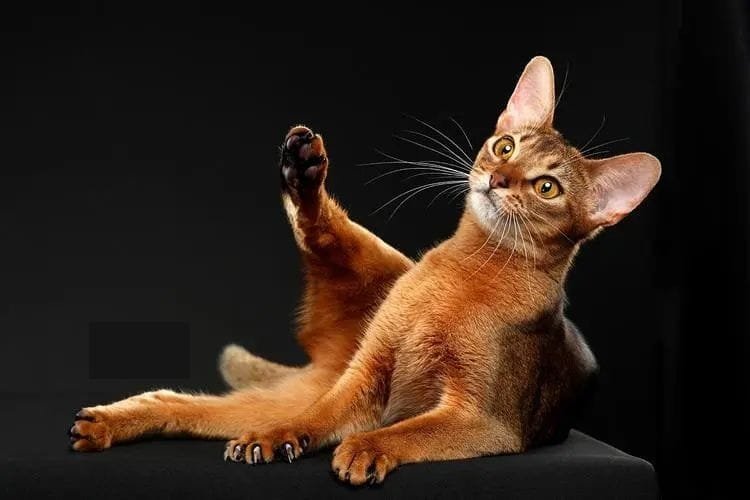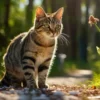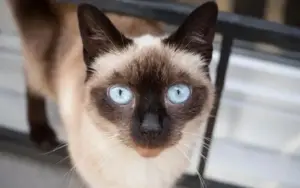Table of Contents
Decoding the Abyssinian Cat
The Abyssinian cat (Abyssinian), a domesticated cat breed, belongs to the order Carnivora, family Felidae, and genus Felis.
Also known as the „Abby,“ „Red Abyssinian,“ „Bunny Cat,“ „Ethiopian Cat,“ or „Ballet Cat,“ this breed is characterized by its wedge-shaped or slightly rounded triangular head, large upright ears with a broad base and pointed tips that tilt forward, large expressive eyes, and a tapered tail. Its soft, dense coat comes in colors such as ruddy (original reddish-brown), red, blue, and fawn.
With a slender build and a weight range of 4–7.5 kg, the Abyssinian is well-suited for family life and has a lifespan of 12–15 years. Known for its lively, affectionate, and gentle temperament, the Abyssinian is relatively quiet, highly clean, and enjoys interactive play with humans. Its sharp memory and intelligence have earned it the nickname „the Border Collie of the cat world.“
The Abyssinian is one of the oldest cat breeds, with debated origins. Some theories suggest it originated in Abyssinia (modern-day Ethiopia) in East Africa, ancient Egypt, or the Indian Ocean coast. Today, it is found across Europe, Africa, and Asia.
Notably, medical researchers study Abyssinian cats due to their susceptibility to eye diseases resembling human retinal disorders, providing insights into treatments for human vision conditions. Additionally, the mapping of the Abyssinian’s genome has revealed genetic similarities between cats and humans, contributing to advancements in genetic research.
An Ancient and Noble Lineage
The Abyssinian boasts a long and enigmatic history.
Legend traces its ancestry to the sacred cats revered as divine beings in ancient Egypt, with depictions in Egyptian murals and texts closely resembling the modern Abyssinian.
In the 19th century, the breed was introduced to Britain from Ethiopia (then Abyssinia), marking the start of its spread across Europe. Early breeding efforts in Britain faced challenges, such as stabilizing the breed’s traits, but through persistent dedication, breeders established its distinct standards.
In 1871, Abyssinians made their debut at the Crystal Palace Cat Show in London, captivating audiences and paving the way for their global popularity. Today, they remain a cherished companion worldwide.
Graceful and Agile Physique

Coat Colors:
One of the most striking features of the Abyssinian cat is its unique coat.
The most common color is a warm „ruddy“ hue, which is not a single solid shade. Instead, each hair transitions from a darker tip to a lighter root, creating a mesmerizing „ticked“ effect. This gives the impression that each strand has been meticulously painted, casting an ethereal glow over the cat’s body.
Beyond the classic ruddy shade, Abyssinians also come in blue, chocolate, lilac, and other color variations, each exuding its own charm. For example, blue Abyssinians boast a soft, muted coat that radiates tranquility and elegance.
Body Structure
Abyssinians are medium-sized, slender, and muscular. Their compact, streamlined bodies convey both grace and agility. The head is wedge-shaped, complemented by large, pointed ears that tilt slightly forward, as if perpetually attuned to their surroundings. Their large, almond-shaped eyes—typically green or gold—gleam with intelligence and curiosity.
Coat Texture
The Abyssinian’s short, dense coat is soft, smooth, and springy to the touch. This low-maintenance fur requires minimal grooming, making it ideal for busy pet owners.

Lively and Intelligent Companions
Energetic Nature
Abyssinians are vivacious and endlessly energetic. Like tireless sprites, they love scampering around the house, exploring every nook and cranny. Whether chasing toys, scaling cat trees, or engaging in interactive play, they thrive on activity.
Owners are encouraged to provide stimulating toys like feather wands or balls to bond with these spirited felines.
Sharp Intelligence
Renowned for their high IQ, Abyssinians quickly grasp their owner’s intentions and commands. They are quick learners, capable of mastering tricks such as responding to their name, fetching items, or even solving puzzle toys.
For instance, with consistent training, an Abyssinian will dart to its owner’s side upon hearing a call. Their insatiable curiosity drives them to investigate every novelty in their environment.
Affectionate Temperament
Despite their boundless energy, Abyssinians are gentle and deeply affectionate toward their humans. They crave companionship, often rubbing against their owners or emitting soft purring sounds to express contentment. These social cats harmonize well with children and other pets, making them ideal family companions.
Daily Care with Diligence
Diet
To ensure the healthy growth of Abyssinian cats, a balanced diet is essential. High-quality cat food, rich in protein, fats, vitamins, and minerals, should form the core of their diet. Additionally, they can be given small portions of meat, such as chicken or fish, to meet their protein needs. However, avoid feeding them excessive human food, especially items containing salt, sugar, or seasonings, as these may harm their health. Fresh, clean water should always be available.
Health Care
Regular veterinary checkups and vaccinations are vital for maintaining their well-being. Kittens typically require FVRCP and rabies vaccines at specific ages, while adult cats need annual boosters and checkups.
Dental hygiene is important—brush their teeth regularly to prevent oral diseases. Additionally, clean their ears, eyes, and claws routinely by removing earwax, eye discharge, and trimming nails to ensure overall health.
Living Environment
Abyssinians are energetic and require ample space for activity. A spacious, comfortable home equipped with cat trees, scratching posts, and toys is ideal to satisfy their natural instincts for climbing and exploration. A clean litter box is also crucial; regular cleaning ensures hygiene and prevents health issues.
The Abyssinian's Influence in the Feline World
Abyssinians hold a prominent place in the cat world due to their distinctive appearance and charming personality. At cat shows, their elegant posture and confident demeanor often captivate judges and audiences. Breeders dedicatedly work to refine the breed, preserving its unique traits and quality. These cats also inspire artists, frequently appearing in paintings, photographs, and other artworks, further elevating their popularity and cultural impact.
In summary, the Abyssinian cat—with its ancient heritage, striking looks, and lively intelligence—has become a beloved companion for cat enthusiasts. If you seek a charismatic feline friend, the Abyssinian may be an excellent choice. However, thoroughly research their needs beforehand to provide a warm, comfortable home where they can thrive.









Add comment